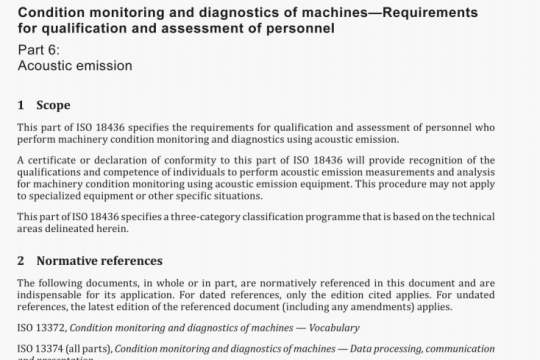ISO 10683:2018 pdf free
ISO 10683:2018 pdf free.Fasteners – Non-electrolytically applied zinc flake coating systems
A characteristic of zinc flake coating systems is that hydrogen is not generated during the deposition process.
Pre-treatment processes using alkaline/solvent cleaner followed by mechanical cleaning do not generate hydrogen, thus eliminating all risk of internal hydrogen embrittlement (IHE).
When mechanical cleaning is not suitable for functional reasons (e.g. for fasteners with captive washers, fasteners with internal threads, fasteners to be rack coated), chemical cleaning (pickling) may be applied, provided that acid with suitable inhibitor and minimum cleaning cycle time are used to minimize the risk of internal hydrogen embrittlement. Fasteners with hardness greater than 390 HV or property class 12.9 and above shall not be subjected to acid cleaning. The duration between cleaning and coating shall be as short as possible.
A phosphating process is permitted as an alternative to mechanical cleaning ( hydrogen may be generated during this pre-treatment process, however the curing process allows outward diffusion).
The duration between phosphating and coating shall be as short as possible.
Cathodic cleaning processes are not permitted.
NOTE Zinc flake coatings have a high permeability for hydrogen which, during the curing process, allows outward diffusion of hydrogen that could have been absorbed during the pre-treatment process.
Elevated temperature can affect the corrosion protection of the coated fasteners. This test is specified for in-process control; it is not intended to check the behaviour of the coated fasteners together with the assembled parts.
After heating the coated fasteners for 3 h at 150 °C [part temperature) the corrosion resistance requirements as specified in Clause 5 shall still be met.
Other specifications may be agreed at the time of the order.
Coating thickness or coating weight shall be determined using one of the following test methods:
– magnetic inductive techniques (determination of the total local thickness, on measuring areas);
– X-ray techniques (this method is only capable to determine the local thickness of the base coat, on measuring areas);
– chemical or mechanical removal of the coating system (determination of the average total coating weight of the fastener);
– microscopic method in accordance with ISO 1463 (determination of the total local thickness, on any area(s) of the fastener).
In case of dispute, the microscopic method in accordance with ISO 1463 shall be used. The thickness shall be measured on the reference areas specified in Figure 2, unless otherwise agreed.ISO 10683 pdf download.




